
Fund helps supply gear to military dogs
Lambertville woman’s organization dedicated to K-9 heroes
1/12/2014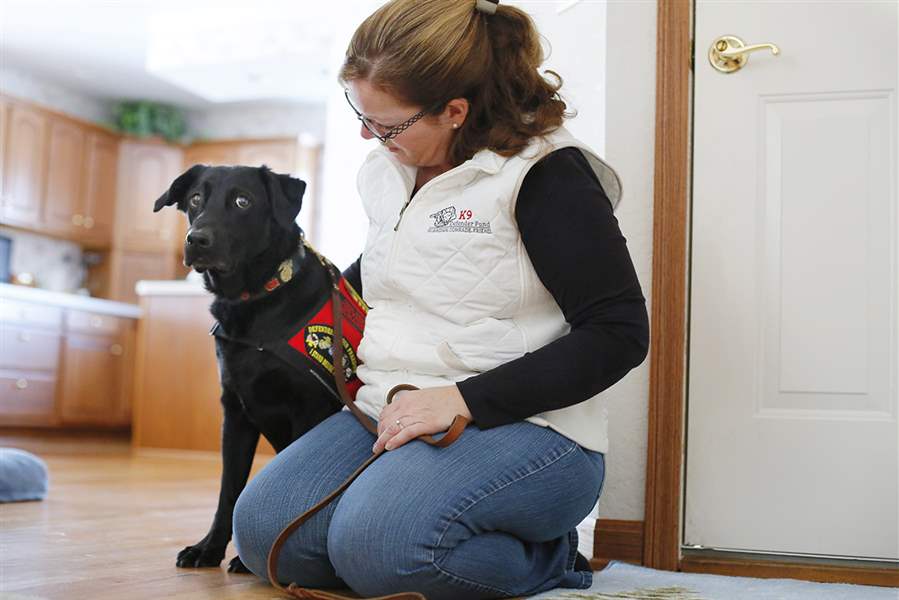
Tracy Spader of Lambertville adopted Jig, a Labrador retriever who was an explosives detection dog with the Marines. Jig served in Afghanistan from 2008 to 2011 until he was diagnosed with oral melanoma. He is now in remission.
THE BLADE/AMY E. VOIGT
Buy This Image

Tracy Spader of Lambertville adopted Jig, a Labrador retriever who was an explosives detection dog with the Marines. Jig served in Afghanistan from 2008 to 2011 until he was diagnosed with oral melanoma. He is now in remission.
LAMBERTVILLE — The folded American flag above the fireplace in Tracy Spader’s Lambertville home is uncommon, not for its meaning and purpose, but for whom it honors.
While Mrs. Spader’s son serves in the Air Force, the flag actually honors a dog — Buddy, a 13-year-old Chesapeake Bay retriever. Buddy was an explosives detection dog who served with the Transportation Security Administration in Puerto Rico before he was retired and later adopted by the Spader family in 2010.
“I’ve always been a lover of dogs,” Mrs. Spader, 54, said. “I had the opportunity to see some military working dogs at an Air Force event and watch them with their handlers. I started trying to adopt a military dog.”
She had volunteered with Support Military Working Dogs of Donnelsville, west of Springfield, Ohio, that supplied gear to military working dogs and learned through those connections that many dog teams are lacking critical gear for one reason or another. That group’s activities fizzled after the sudden death of its founder, so in October, Mrs. Spader founded the K9 Defender Fund to help supply military dog units with needed gear.
“These dogs are soldiers,” she said.
“They’re serving right alongside our men and women and put themselves in danger every day. They’re amazing.”
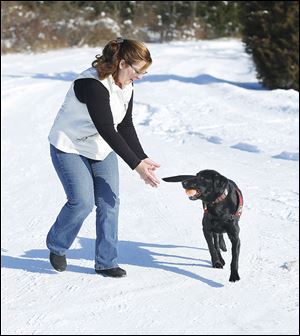
SLUG: CTY K9DEFENDERxxp 1/9/2014 The Blade / Amy E. Voigt Lambertville, MI CAPTION: Tracy Spader, and her dog Jig, a former military dog, play in the snow with a ball at their home on January 9, 2014.
Key assets
Ron Aiello, president of the U.S. War Dogs Association, which also sends supplies to dog units, said there are an estimated 600 to 700 dogs serving in the Middle East and about 3,200 units across all branches of the military.
“They’re a very important asset to the military today,” he said. “The way they’ve been utilized in Iraq and Afghanistan, they’ve saved thousands upon thousands of lives. And not just military lives, but civilian lives as well.”
The first U.S. dog of war, Sgt. Stubby, was the mascot of the U.S. Army’s 102nd Infantry, 26th Yankee Division in World War I. Stubby predated the formal K-9 program, which started during World War II.
The “pit bull”-type dog showed up at training camp one day on the grounds of Yale University in New Haven, Conn., and was such a hit with the soldiers that he was allowed to stay. He would drill with them and even learned to salute.
When it was time to ship off for Europe, Stubby went along for the ride to Newport News, Va., and was smuggled by Pvt. Robert Conroy aboard the SS Minnesota. Upon discovery by Private Conroy’s commanding officer, the story goes, Stubby saluted him. The commanding officer was so impressed that he allowed Stubby to remain with the troops, where he stayed for 18 months. Stubby entered combat on Feb. 5, 1918, at Chemin des Dames in France, and went on to participate in four offensives and 17 battles. He died in 1926.
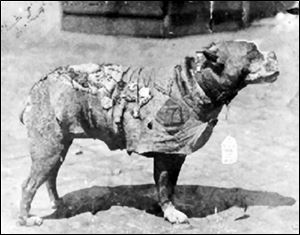
Sgt. Stubby, a bull terrier mix, went through World War I with the 102nd Infantry as the ‘official unofficial’ mascot. A ‘pit bull’-type dog, Sgt. Stubby wears a chamois coat on which were pinned his many medals.
In harm’s way
Dogs and their handlers are often the military’s first line of defense, protecting the rest of the unit from dangers such as hidden insurgents and improvised explosive devices along convoy routes.
“That dog and that handler are responsible for clearing the road so that the unit behind them can walk the road without stepping and worrying about detonating some kind of explosive device,” Mrs. Spader said. “The K-9s themselves, the dogs and their handlers, are usually a target. Insurgents know those dogs are good at what they do and they usually are the ones that they go after first.”
Mrs. Spader partnered with the Fetch Foundation to supply K-9 units with Fido Bags. The $225 kits include items such as a specialized oxygen mask, canine endotracheal tube, and first-aid items such as bandages, burn sheets, and medications.
While Fido Bags were originally intended for use by fire departments, Mrs. Spader tailors them for military K-9s. Military medics have oxygen, but they do not have the cone-shaped masks for dogs.
“I don’t know that anybody has used them, but they’re there if they need it,” she said. “I pray to God that they don’t ever have to use it.”
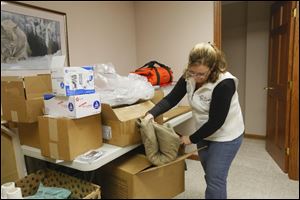
Tracy Spader puts away a blanket that was donated to her K9 Defender Fund by Delta Air Lines. The fund depends entirely on donations to supply military units.
Specialized gear
K9 Defender Fund, which is funded entirely by donations, also will supply specialized K-9 gear if the handlers request it. Mrs. Spader has sent cooling vests, water bottles, harnesses, boots, ear protection, and goggles. She said much of what she sends out isn’t issued by the military.
Mr. Aiello said that while K-9 units are supplied with basic gear, replacing that gear as it wears out is problematic.
“It has to go through all the paperwork and that can take three months,” he said. “They need it now and we try to fill in that gap.”
Mrs. Spader also supplies equipment for the handlers themselves. If she sends a canine cooling vest, she’ll send a cooling pack for the handler too.
“I tell them, ‘This is my way of nagging you from 7,000 miles away. When your vest isn’t cooling you, it’s not cooling your dog.’ So it’s a reminder to them,” she said.
One corner of her home’s basement is taken over by boxes of supplies for the K9 Defender Fund. So far, Mrs. Spader has supplied 12 military units with Fido Bags and other gear. One unit was a kennel of 31 dogs with the U.N. World Food Program.
Staff Sgt. Loretta Streichert is serving with the Army’s 100th Military Working Dog Detachment out of Italy. K9 Defender Fund has sent her a Fido Bag and care packages for her explosives detection K-9, 4-year-old German shepherd Edo.
“At times, the military doesn’t provide some of the smaller items for [military working dogs],” she said in an email to The Blade, noting dog goggles and ear protection specifically. “The Fido Bag has a splint in it that is perfect for dogs, rather than try to use a human splint on a smaller dog leg!”
Though military dogs are her primary focus, Mrs. Spader has started reaching out to police, fire, and search-and-rescue dog units.
“I’m hoping that in 2014, as our troops start coming home, I can start supplying those others too,” she said.
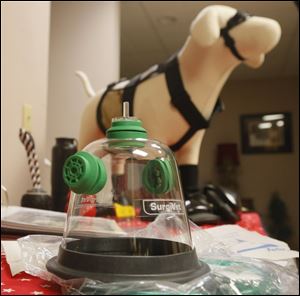
An oxygen mask is among the items contained in a Fido Bag that Tracy Spader distributes through her K9 Defender Fund. The $225 kits also include first-aid items such as bandages, burn sheets, and medications.
A new home
Buddy died of cancer in December, 2012, and his ashes were interred at the Michigan War Dog Memorial in South Lyon, Mich., with full military rites.
Like Buddy, the Spader family’s current dog, 7-year-old black Labrador retriever Jig, is a former explosives detection dog with the U.S. Marine Corps. His military number, M834, is tattooed on the inside of his left ear, and he was given the rank of sergeant.
Some branches of the military, like the Marines, give their dogs a rank as a gesture of respect.
“The idea is to give your dog one rank above yours, and that always reminds you to pay respect to your dog as he’s a higher rank than you," said Mr. Aiello, who served as one of the first Marine scout-dog teams deployed in Vietnam in 1966.
Jig served in Afghanistan from 2008 to 2011 until it was discovered he had oral melanoma. Jig is now in remission.
“If they’re not adopted, they sit in a kennel and that’s where they finish out the rest of their lives,” Mrs. Spader said. “These dogs are heroes, and they deserve to live out their remaining years in comfort.”
While his physical health has improved, Jig suffers from severe post-traumatic stress disorder. He is terrified of new people and situations and startles at the quietest of sounds.
Mrs. Spader purchased a vest for Jig, which she decorated with military patches, to help comfort him as he is accustomed to wearing gear. There’s a dog bed in practically every room of the house for him, but when he’s scared, he makes a beeline for the master bedroom and disappears.
“He finds comfort in his bed, in my room, under my side of the bed,” Mrs. Spader said. “That’s where he likes to be when he’s nervous.”
But bring out a ball and Jig turns into a happy, excited fetching machine.
“The ball was their reward,” Mrs. Spader explained, tossing an orange rubber ball down the snowy driveway for Jig to chase. “He could do this for hours.”
K9 Defender Fund is registered with the state of Michigan, and Mrs. Spader is working on obtaining federal 501(c)3 nonprofit status.
Donations to the organization can be made through its Web site, K9defenderfund.org. Checks made out to K9 Defender Fund may be sent to 8893 Summerfield Rd., Lambertville, Mich. 48144.
Contact Alexandra Mester: amester@theblade.com, 419-724-6066, or on Twitter @AlexMesterBlade.